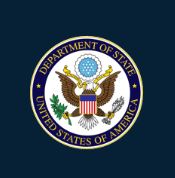Chapter 2: Landmark Policies in Trafficking in the USA and Trafficking in Persons Ratings Across the Globe
ABSTRACT
The Trafficking Victims Protection Act (TVPA) and its subsequent reauthorizations are landmark polices in the United States of America. Along with the TVPA, annual Trafficking in Persons (TIP) reports detail the efforts of over 100 countries and their attempts at eliminating trafficking in persons. This chapter will discuss the TVPAs and the ranking of TIP reports.
Learning Objectives
By the end of this chapter, the student will be able to:
- Understand the basic tenets of Trafficking Victims Protection Acts
- Describe the purpose of Trafficking in Persons reports
- Understand TIP ratings
Key Word: Trafficking in Persons
GLOSSARY
Trafficking in Persons [TIP]: The recruitment, transportation, transfer, habouring or receipt of persons, by means of the threat or use of force or other forms of coercion, of abduction, of fraud, of deception, of the abuse of power or of a position of vulnerability or of the giving or of receiving of payments or benefits to achieve the consent of a person having control over another person, for the purpose of exploitation
Trafficking Victims Protection Acts (TVPA)
This chapter will examine the Trafficking Victims Protection Act (TVPA) of 2000 and its subsequent reauthorizations in 2003, 2005, 2008, 2013 and 2017 that were implemented to combat trafficking in persons. The TVPA is a seminal piece of federal legislation. Before the landmark Trafficking Victims Protection Act (TVPA) in 2000, however, there was the 13th Amendment in 1865 that abolished the slavery of Africans and their descendants (except for any person who is imprisoned). The TVPA attempts to prevent and protect all victims of modern-day slavery, who are outside the penal system.
According to the TVPA, sex trafficking involves the recruitment, harboring, transportation, provision, or obtaining of a person for the purpose of a commercial sex act (CSA), in which a CSA is induced by force, fraud, or coercion, or in which the person induced to perform such act has not attained 18 years of age. Labor trafficking involves the recruitment, harboring, transportation, provision, or obtaining of a person for labor or services, through the use of force, fraud, or coercion, for the purpose of subjection to peonage, debt bondage, involuntary servitude or slavery (Pub. L. 106-386).
The first Trafficking Victims Protection Act has evolved since its inception in 2000. More populations are included in subsequent reauthorizations and attempts at better protecting victims and prosecuting perpetrators are indicated in language and approaches in the revised Acts. The following is a summary of these Acts.
Summaries of Trafficking Victims Protection Acts
Pub. L. 106-386. (2000). Trafficking Victims Protection Act of 2000, H. R. 3244, (2000). 106th Cong., 2nd Sess. Retrieved from https://www.congress.gov/106/plaws/publ386/PLAW-106publ386.pdf
This is the first of several federal laws enacted in the United States that has been put into place to address human trafficking. Specifically, it was enacted to protect trafficking victims and punish traffickers. Its three thrusts include: protection, prosecution and prevention (ATEST, 2017). This Act is 86 pages in length.
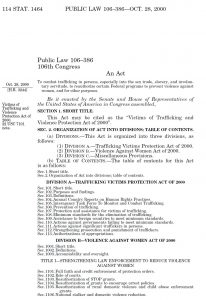
Pub. L. 108-193. (2003). Trafficking Victims Protection Reauthorization Act of 2003, 108th Cong., 1st Sess. Retrieved from https://www.govinfo.gov/content/pkg/PLAW-108publ193/pdf/PLAW-108publ193.pdf
This Act allowed for materials to be developed and disseminated to alert travelers that sex tourism is illegal. It also allowed for trafficking survivors to sue their traffickers in federal district court. Additionally, it required the Attorney General to report on anti-trafficking efforts on a yearly basis (ATEST, 2017). This Act is 13 pages in length.
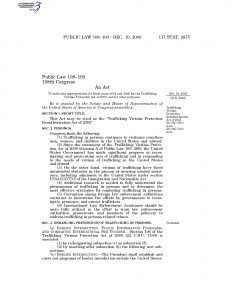
Pub. L. 109-164. (2005). Trafficking Victims Protection Reauthorization Act of 2005, 109th Cong., 1st Sess. Retrieved from https://www.govinfo.gov/content/pkg/PLAW-109publ164/pdf/PLAW-109publ164.pdf
This Act added measures to protect U.S. citizens who are survivors. Earlier editions of the TVPA focused on foreign nationals. Measures in this Act included: rehabilitative facilities; comprehensive service facilities; grant programs to assist state and local law enforcement in fighting human trafficking and to expand victim assistance; and the provision of extraterritorial jurisdiction over trafficking offenses committed overseas by government contractors (ATEST, 2017). This Act is 17 pages in length.
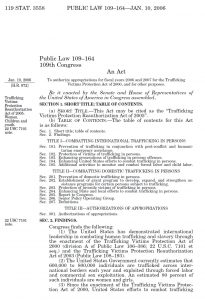
Pub. L. 110-457 (2008). William Wilberforce Trafficking Victims Protection Reauthorization Act of 2008, H. R. 7311, 110th Cong., 2nd Sess. Retrieved from https://www.govinfo.gov/content/pkg/PLAW-110publ457/pdf/PLAW-110publ457.pdf
This Act was named in honor of William Wilberforce, an instrumental figure and abolitionist in the fight against transatlantic slavery. This Act strengthened the Department of Justice’s efforts to protect human trafficking victims, prevent human trafficking, and to prosecute human traffickers. It also gave the Department of Labor more tools to better document forced labor and labor trafficking. The Department of Health and Human Services was also assisted in providing services to trafficked victims, especially children (ATEST, 2017). This Act is 49 pages in length.
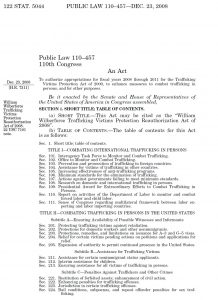
Pub. L. 113-4. (2013). Trafficking Victims Protection Reauthorization Act of 2013, H.R. 898, 113th Cong., 1st Sess. Retrieved from https://www.govinfo.gov/content/pkg/BILLS-113hr898ih/pdf/BILLS-113hr898ih.pdf
This Act was passed as an amendment to the Violence Against Women Act (VAWA). It is intended to ensure that U.S. citizens do not purchase goods produced by trafficked persons; to prevent child marriages; to improve the ease of charging and prosecuting traffickers; and to put in place emergency provisions (U.S. State Department) to quickly respond to disaster areas/crises where vulnerable persons are at risk for being trafficked (ATEST, 2017). This Act is 66 pages in length.
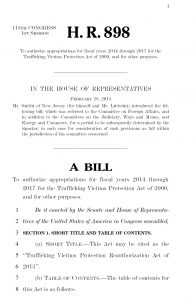
Publ. L. 115-427. (2017). Trafficking Victims Protection Act of 2017, H.R. 4061, 115th Cong., 2nd Sess. Retrieved from https://www.govinfo.gov/content/pkg/BILLS-115s1312enr/pdf/BILLS-115s1312enr.pdf
This Act serves to prevent human trafficking; promote justice for trafficking survivors; provide services to trafficking survivors; promote federal coordination between FBI, Congress, and Department of Homeland Security; and to provide training to federal/tribal law enforcement and judges on human trafficking (Grassley et al., 2017). This Act is 16 pages in length.
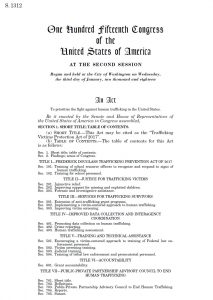
Publ. L. 115-392. (2017). Abolish Human Trafficking Act of 2017, S. 1311/H.R. 2803, 115th Cong., 2nd Sess. Retrieved from https://www.govinfo.gov/content/pkg/BILLS-115s1311enr/pdf/BILLS-115s1311enr.pdf
This act strengthens and reauthorizes key initiatives that support human trafficking survivors. It also provides resources to law enforcement officials (Office on Trafficking in Persons, 2018). This Act is 15 pages in length. Specific measures include:
- restitution for victims;
- funding of investigations of offenses relating to sexual abuse of children;
- grants to states and localities and other entities for victim service assistance;
- training of health, victim service, and federal law enforcement personnel, including through the use of a victim-screening protocol by the Department of Homeland Security;
- penalties imposed for slavery offenses, sex trafficking of children, and repeat convictions for transportation for illegal sexual activity and related crimes;
- travel for the purpose of engaging in any illicit sexual conduct;
- designation of additional Department of Justice resources for prosecution and service coordination;
- penalties for offenses involving organized human trafficking, sexual abuse, sexual exploitation, or transportation for prostitution or any illegal sexual activity; and
- studies of the physical and psychological effects of serious harm to victims.
(Congress.gov, 2018, “Summary” section)
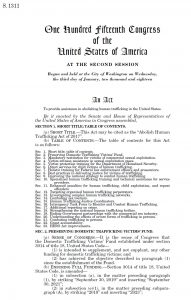
Pub. L. 115-425. (2018). Frederick Douglass Trafficking Victims Prevention and Protection Reauthorization Act of 2018, H.R. 2200, 115th Cong., 2nd Sess. Retrieved from https://www.congress.gov/115/bills/hr2200/BILLS-115hr2200enr.pdf
This Act was named in honor of Frederick Douglass. He was a former slave, an outspoken abolitionist and an orator. This Act establishes programs to fight human trafficking, forced labor, and the use of child soldiers. It also includes mechanisms to better analyze and rank countries in their efforts to eliminate trafficking; exempt restitution for trafficking survivors from federal taxes; and bolster efforts to prevent products made from forced labor from entering into the United States. Last, it increases support for the United States Advisory Council on Human Trafficking (Polaris, 2019; Pub. L. 115-425, 2018). This Act is 17 pages in length.
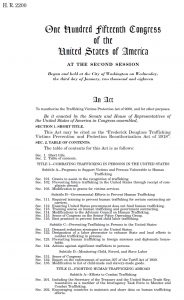
Trafficking in Persons Report
The Trafficking in Persons (TIP) report comes out of the Office to Monitor and Combat Trafficking in Persons. This office releases annual ratings of nations around the world. The ratings are based on a country’s adherence to the U.S.’s recommendations for eradicating trafficking. The annual production of the TIP report is a requirement of the Trafficking Victims Protection Reauthorization Act of 2008 (H.R. 7311, 2008).
The TIP report ranks nations as Tier I, Tier II, Tier II Watch List, and Tier III based on their attention and efforts to address human trafficking as set by the minimum standards of the Trafficking Victims Protection Reauthorization Act. These standards address the three P’s: Punishment of traffickers, Protection of its victims, and Prevention efforts related to trafficking.
Tier Rankings
- Tier I countries fully comply with the minimum standards of the TVPA.
- Tier II countries do not fully comply with the minimum standards of the TVPA but are making significant efforts to do so.
- Tier II Watch List countries do not fully comply with the minimum standards of the TVPA but are making progress toward being in compliance but have additional barriers to address related to high numbers or increasing number of victims; failure to prove increasing efforts to address severity of trafficking; or a prior commitment to make great improvements that has not been upheld.
- Last, Tier III countries do not fully comply with the minimum standards of the TVPA and are not making progress toward such goals.
The following table ranks the countries that are assessed and scored on their anti-trafficking efforts (Office to Monitor and Combat Trafficking in Persons, 2019). Please see below.
| Tier 1 | Tier 2 | Tier 2 Watch List | Tier 3 |
| Argentina Australia Austria The Bahamas Bahrain Belgium Canada Chile Colombia Cyprus Czech Republic Estonia Finland France Georgia Guyana Israel Japan Korea, South Lithuania Luxembourg Netherlands New Zealand Norway Philippines Portugal Slovenia Spain Sweden Switzerland Taiwan United Kingdom United States of America |
Albania Antigua & Barbuda Armenia Aruba Benin Botswana Brazil Bulgaria Burkina Faso Cabo Verde Cameroon Chad Costa Rica Cote d’Ivoire Croatia Denmark Djibouti Dominican Republic Ecuador Egypt El Salvador Ethiopia Eswatini Germany Ghana Greece Guatemala Guinea Haiti Honduras Hong Kong Iceland India Indonesia Ireland Italy Jamaica Jordan Kenya Kosovo Kuwait Latvia Lebanon Macau Macedonia Madagascar Mali Malta Mauritius Mexico Micronesia Moldova Mongolia Morocco Mozambique Namibia Nepal Niger Nigeria Oman Pakistan Palau Panama Paraguay Peru Poland Qatar Rwanda St. Lucia St. Maarten St. Vincent & The Grenadines Senegal Serbia Seychelles Singapore Slovakia Solomon Islands Suriname Tajikistan Thailand Timor-Leste Togo Tonga Trinidad & Tobago Tunisia Turkey Uganda Ukraine United Arab Emirates Uruguay Zambia Zimbabwe |
Afghanistan Algeria Angola Azerbaijan Bangladesh Barbados Belize Brunei Bolivia Bosnia & Herzegovina Cambodia Central African Republic Congo, Republic of the Curacao Fiji Gabon Guinea-Bissau Hungary Iraq Kazakhstan Kyrgyz republic Laos Lesotho Liberia Malawi Malaysia Maldives Marshall Islands Montenegro Nicaragua Romania Sierra Leone South Africa Sri Lanka Sudan Tanzania Uzbekistan Vietnam |
Belarus Bhutan Burma Burundi China (PRC) Comoros Congo, Democratic Rep. of the Cuba Equatorial Guinea Eritrea The Gambia Iran Korea, North Mauritania Papua New Guinea Russia Saudi Arabia South Sudan Syria Turkmenistan Venezuela |
Tier Placements
As the reader can see from this table, the United States, Canada and many European countries are ranked Tier 1. Most countries in the world, however, rank as Tier 2 and no countries in Africa rank as Tier 1. China, a country with over one billion people and is persistently accused of human rights violations is ranked as Tier 3, along with other countries that are deemed problematic for trafficking offenses that include North Korea, Iran, South Sudan, the Congo and Mauritania. Mauritania is the last country in the world to outlaw slavery, which was in 1981 (Guardian, 2018).
While Tier 1 is the highest and most desired ranking, it does not mean that a Tier 1 country does not have a human trafficking problem; nor does it mean that a country is doing enough to eliminate trafficking. A Tier 1 ranking indicates that a government has made efforts to address human trafficking in a manner that meets the TVPA’s minimum standards. To maintain a Tier 1 ranking, however, those governments must demonstrate continued progress on an annual basis in combating human trafficking (Office to Monitor and Combat Trafficking in Persons, 2019).
In addition to Tier rankings in the TIP report, countries are presented with a narrative that reflect an assessment of the following:
- enactment of laws prohibiting severe forms of trafficking in persons, as defined by the TVPA, and provision of criminal punishments for trafficking offenses;
- criminal penalties prescribed for human trafficking offenses with a maximum of at least four years’ deprivation of liberty, or a more severe penalty;
- implementation of human trafficking laws through vigorous prosecution of the prevalent forms of trafficking in the country and sentencing of offenders;
- proactive victim identification measures with systematic procedures to guide law enforcement and other government-supported front-line, responders in the process of victim identification;
- government funding and partnerships with NGOs to provide victims with access to primary health care, counseling, and shelter, allowing them to recount their trafficking experiences to trained social counselors and law enforcement in an environment of minimal pressure;
- victim protection efforts that include access to services and shelter without detention and with legal alternatives to removal to countries in which victims would face retribution or hardship;
- the extent to which a government ensures victims are provided with legal and other assistance and that, consistent with domestic law, proceedings are not prejudicial to victims’ rights, dignity, or psychological well-being;
- the extent to which a government ensures the safe, humane, and to the extent possible, voluntary repatriation and reintegration of victims;
- governmental measures to prevent human trafficking, including efforts to curb practices identified as contributing factors to human trafficking, such as employers’ confiscation of foreign workers’ passports and allowing labor recruiters to charge fees to prospective migrants; and
- governmental efforts to reduce the demand for commercial sex acts and international sex tourism.
(Office to Monitor and Combat Trafficking in Persons, 2019, “Tier Placement” section)
FUNDING RESTRICTIONS FOR TIER 3 COUNTRIES
Pursuant to the TVPA, governments of countries on Tier 3 may be subject to certain restrictions on assistance that include:
- the President of the USA may decide not to provide U.S. government nonhumanitarian, nontrade-related foreign assistance
- the President may decide to withhold funding for government official or employee participation in educational and cultural exchange programs
- the President may also decide to instruct the U.S. Executive Director of each multilateral development bank and the International Monetary Fund to vote against and use his or her best efforts to deny any loans or other uses of the institutions’ funds to a designated Tier 3 country for most purposes (except for humanitarian, trade-related, and certain development-related assistance)
- At the same time, the President [of the United States of America] may waive application of the foregoing restrictions upon a determination that the provision to a Tier 3 country of such assistance would promote the purposes of the TVPA or is otherwise in the national interest of the United States. The TVPA also authorizes the President to waive funding restrictions if necessary to avoid significant adverse effects on vulnerable populations, including women and children
(Office to Monitor and Combat Trafficking in Persons, 2019, Funding Restrictions section)
Quiz
Now, let’s shift gears and turn to a case study.
Adélaïde Sawadogo is a proven, unwavering force against human trafficking in Burkina Faso. For the past 26 years, she has worked unrelentingly to protect vulnerable populations. Sawadogo is a social worker at Keoogo, an NGO specializing in child protection and advocacy. At the helm of Keeogo’s [anti-] human trafficking efforts, Sawadogo has directly assisted more than 1,500 human trafficking victims, including those whom the government does not have the resources to support. Serving on more than a dozen national and international committees, she has represented Keeogo’s rights-based model for victims and influenced government policy on human trafficking and child protection. She has accompanied human trafficking victims back to their country of origin to ensure safe passage through insecure regions and across borders, liaising with border officials and police along the journey. She has worked together with human trafficking survivors to design reintegration programs focused on income-generating skills that foster economic stability. Sawadogo not only secured pro-bono legal counsel for survivors wishing to press charges against their traffickers, she also followed up with the Burkinabe government to ensure these cases progressed.
Undaunted by discrimination and threats of violence, Sawadogo has challenged traditional norms and religious precepts to combat forced begging of children by corrupt Quranic teachers and worked to increase access to health care for children in some of Ouagadougou’s most dangerous neighborhoods.
(Office to Monitor and Combat Trafficking in Persons, 2019, TIP Heroes section)
Summary of Key Points
- The annual release of the Trafficking in Persons report is critical to understanding diverse international governments’ response to human trafficking activities.
- The TIP report ranks nations as Tier I, Tier II, Tier II Watch List, and Tier III based on their attention and efforts to address human trafficking as set by the minimum standards of the Trafficking Victims Protection Reauthorization Act.
Supplemental Learning Materials
Office to Monitor and Combat Trafficking in Persons. (2019, June). Trafficking in Persons Report. Retrieved from https://www.state.gov/wp-content/uploads/2019/06/2019-Trafficking-in-Persons-Report.pdf
References
Alliance to End Slavery & Trafficking [ATEST]. (2017). Summary of the Trafficking Victims Protection Act (TVPA) and Reauthorizations FY 2017. Retrieved from https://endslaveryandtrafficking.org/summary-trafficking-victims-protection-act-tvpa-reauthorizations-fy-2017-2/
Bacon, C., & Breevort, L. (2018, August 8). 2018 TIP Report: Important rankings to know. Retrieved from https://humantraffickingcenter.org/2018-tip-report-important-rankings-to-know/
Congress.gov. (2018). S.1311 – Abolish Human Trafficking Act of 2017. Retrieved from https://www.congress.gov/bill/115th-congress/senate-bill/1311
Grassley et al. (2017, June 7). Trafficking Victims Protection Act of 2017. Retrieved from https://www.judiciary.senate.gov/imo/media/doc/TVPRAOnePager7June2017.pdf
Guardian (The). (2018, June 8). The unspeakable truth about slavery in Mauritania. Retrieved from theguardian.com
Office on Trafficking in Persons. (2018, December 21). President signs the Abolish Human Trafficking Act of 2017 (S. 1311). Retrieved from https://www.acf.hhs.gov/otip/news/s-1311
Office to Monitor and Combat Trafficking in Persons. (2019, June 20). 2019 Trafficking in Persons Report. Retrieved from https://www.state.gov/reports/2019-trafficking-in-persons-report/
Polaris. (2019). Reauthorizing the Trafficking Victims Protection Act. Retrieved from https://polarisproject.org/blog/2017/06/29/reauthorizing-trafficking-victims-protection-act
Pub. L. 106-386. (2000). Trafficking Victims Protection Act of 2000, H. R. 3244, (2000). 106th Cong., 2nd Sess. Retrieved from https://www.congress.gov/106/plaws/publ386/PLAW-106publ386.pdf
Pub. L. 108-193. (2003). Trafficking Victims Protection Reauthorization Act of 2003, H.R. 2620, 108th Cong., 1st Sess. Retrieved from https://www.govinfo.gov/content/pkg/PLAW-108publ193/pdf/PLAW-108publ193.pdf
Pub. L. 109-164. (2005). Trafficking Victims Protection Reauthorization Act of 2005, H.R. 972, 109th Cong., 1st Sess. Retrieved from https://www.govinfo.gov/content/pkg/PLAW-109publ164/pdf/PLAW-109publ164.pdf
Pub. L. 110-457 (2008). William Wilberforce Trafficking Victims Protection Reauthorization Act of 2008, H. R. 7311, 110th Cong., 2nd Sess. Retrieved from https://www.govinfo.gov/content/pkg/PLAW-110publ457/pdf/PLAW-110publ457.pdf
Pub. L. 113-4. (2013). Trafficking Victims Protection Reauthorization Act of 2013, H.R. 898, 113th Cong., 1st Sess. Retrieved from https://www.govinfo.gov/content/pkg/BILLS-113hr898ih/pdf/BILLS-113hr898ih.pdf
Publ. L. 115-392. (2017). Abolish Human Trafficking Act of 2017, S. 1311/H.R. 2803, 115th Cong., 2nd Sess. Retrieved from https://www.govinfo.gov/content/pkg/BILLS-115s1311enr/pdf/BILLS-115s1311enr.pdf
Pub. L. 115-425. (2018). Frederick Douglass Trafficking Victims Prevention and Protection Reauthorization Act of 2018, H.R. 2200, 115th Cong., 2nd Sess. Retrieved from https://www.congress.gov/115/bills/hr2200/BILLS-115hr2200enr.pdf
Pub. L. 115-427. (2017). Trafficking Victims Protection Act of 2017, H.R. 4061, 115th Cong., 2nd Sess. Retrieved from https://www.govinfo.gov/content/pkg/BILLS-115s1312enr/pdf/BILLS-115s1312enr.pdf
Sharedhope International. (2019). What is the TVPRA and why is it important? Retrieved from https://sharedhope.org/what-we-do/bring-justice/legislative-action-center/2017-federal-advocacy-115th-congress-2017-2018/tvpra/
